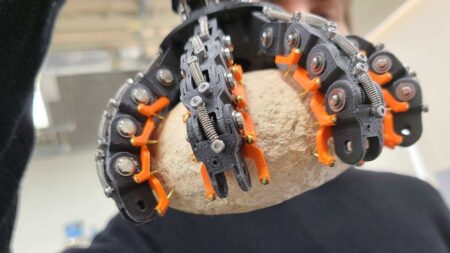Asteroid mining: Helping to meet Earth’s natural resource demands
“They essentially hold on to the side of the asteroid for dear life as it screams through the solar system.”
Mitch Hunter-Scullion is describing a six-legged robot called Scar-e, the Space Capable Asteroid Robotic Explorer, which he aims to send to an asteroid to drill for precious metals such as iron, nickel and platinum.
As well as being increasingly essential for phones, laptops and cars, some metals like platinum will also be needed to help produce hydrogen as we transition to greener energy.
With only a finite supply of them on earth – people are increasingly looking to space to meet this increased demand.
That’s where Scar-e comes in. Its powerful claw, designed in partnership with Tohoku University in Japan, should grip on to an asteroid in space to stop it from floating away.
It has been inspired by the way tarantulas hang on to walls.
“I am terrified of spiders”, Mitch says, “so I thought that was quite appropriate.”
Mitch is the founder of the Asteroid Mining Corporation (AMC). He admits pulling off such a feat is still a fair way off.
Not only would it involve landing robots on a rock, but also remotely building mining infrastructure, and then somehow sending the materials back to Earth.
But it’s easy to see why he and others want to give it a try.
A new gold (or platinum) mining rush?
Asteroids are made of the same stuff as the rest of the rocky planets in our solar system – and that means they are also rich in some precious minerals we go to great lengths (and depths) to mine here on Earth.
Finding large deposits of platinum on an asteroid, for example, says Mitch, “would allow humanity to start innovating in a way we haven’t done in quite a while”.
Getting resources out of asteroids presents a different challenge to getting them from Earth, says Prof John Bridges, a University of Leicester scientist involved in the Hayabusa2 mission.
This is because these small, inert space rocks have not undergone the same geological processes as their massive planetary cousins.
“They haven’t gone through the… melting, volcanism and mountain forming, which act to concentrate some of the elements in particular parts of the crust. So that’s why on Earth we can have a mine [in a particular place] to extract rare earth elements.”
On an asteroid, “all the elements will still be there”, he says, “but they’ll just be scattered. Nature hasn’t had a chance to concentrate it into ore veins, for example”.
And that means asteroid miners would have to process an awful lot of material, for it to be worthwhile.
Prof Bridges believes commercial space mining is a “fascinating area”, but is doubtful it will solve the world’s resource problem.
The trick, Mitch says, will be finding the right asteroid.
See more here: bbc.co.uk
Header image: AMC/Space Robotics Lab at Tohoku University
Please Donate Below To Support Our Ongoing Work To Defend The Scientific Method
PRINCIPIA SCIENTIFIC INTERNATIONAL, legally registered in the UK as a company 


Howdy
| #
You know, there’s an alternative, but It won’t be acceptable because it centres on using less, or making more of what is allready available. I’ll leave it to the innovators, wherever they are.
How much energy will be expended on this ridiculous endeavour before It even gets off the ground? Once in space, more energy used to catch up to the target, then the target may be useless because there isn’t enough, or any, of the wanted materials? Which materials will they be? Gold and platinum? Yes I thought there must be a larger draw than simply increasing supply of basic materials, but what’s new?
“The trick, Mitch says, will be finding the right asteroid.”
On Earth it’s called a lucky dip…
““They haven’t gone through the… melting, volcanism and mountain forming, which act to concentrate some of the elements in particular parts of the crust.”
This requires knowing how the asteroid was formed and thus not proveable.
More evidence to show science, If you can even call this under that definition, is in retrograde and innovation stalled out long ago. Absolutely ridiculous, cloud cuckoo land. What’s frightening, is that these people are actually invested in it.
Howdy
| #
Wire Cutters [Animated Short] by Jack Anderson
https://youtu.be/3Bs4LOtIuxg